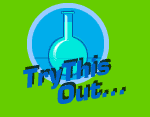
Explore The Properties Of Light
Here are three fun and easy experiments for you to observe the many properties of light. To get started, print this page out and follow along. Visible Light and Rainbows Visible light is composed of all the colors of the rainbow. Together, these colors appear to be white, but they are really a mixture of red, orange, yellow, green, blue, indigo, and violet. How can you test this out at home? It's simple with a few household items. Materials: one used or old CD, candle and matches, flashlight, small lamp, sunlight The back of a compact disc (CD) is etched with tiny grooves, visible only with a microscope. Each groove contains digital ones and zeros–digital information that describes the sound waves of the music. These grooves also happen to diffract light. Let's try to see the visible colors within light with this simple experiment. 1. Start by holding the shiny back of a CD up to the different light sources. Move the CD around at an angle for better results. 2. If the sun is out, try reflecting sunlight on the CD. What kinds of colors are reflected? 3. With your parent's permission, light a candle and turn out the lights. Hold the CD away from the candle and view the shiny side as it faces the flame. Do you see how the light is diffracted into many colors? Can you think of any other objects that diffract light? Ice Cube Colors This easy experiment will show you the effects of iridescence. Iridescence is an optical phenomenon in which the color of a surface changes if it is viewed at a different angle. Shiny soap bubbles, shimmery butterfly wings, and the nocturnal green glow of cats' eyes are all examples of iridescence. Now you can create your own example right in the kitchen. Materials: ice cube, salt, red food coloring, bowl 1. Take one ice cube and place it in a bowl. 2. Sprinkle a half teaspoon of salt directly on the top of the ice cube. 3. Carefully squeeze a drop of red food coloring over the salty ice cube. Wait a few seconds for the effect to appear. Do you see the green shimmer? Why does this happen? Light Refraction If you've seen large aquarium exhibits, you may have noticed that the fish look bigger or distorted when viewed underwater compared to above the water. Why is this? Light has different behavior in water than in air because water is denser than air. When light hits water, it bends and changes speed in a process called refraction. It's easy to observe refraction at home with a few household items. Materials: a flashlight (with a conventional incandescent bulb, not LEDs), a square (not circular) glass bottle/jug/vase, a 3x3 inch piece of thin cardboard, water, milk, spoon, scissors 1. Cut a narrow slit in the middle of the cardboard, about 2 inches in length. 2. Fill the bottle with a few inches of water. 3. Turn the lights out and shine the flashlight through the slit of the cardboard towards the water. 4. Place the flashlight up close to the vase or bottle. Can you see if the light is bending through the water? 5. Now try adding a teaspoon of milk to the water and stir it up. 6. Now try shining the flashlight through the cardboard into the water. Do you see where the light is bending? You're observing the property of refraction. Can you think of other substances that cause light to refract? Images: Top: A rainbow shows off the many colors of visible light. Credit: Marita Graube Bottom: A student researcher in the photonics center. Courtesy of MDITR

|







